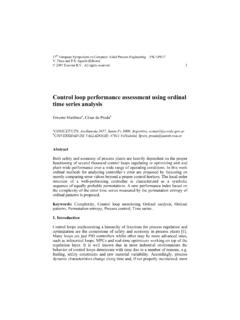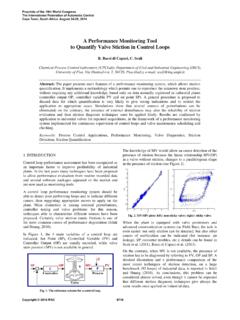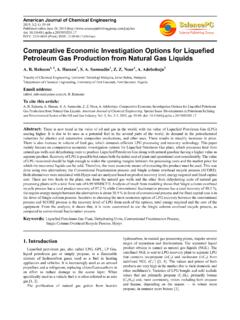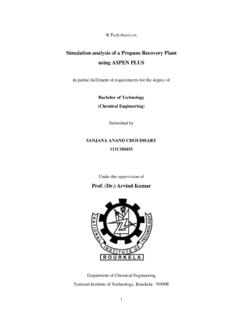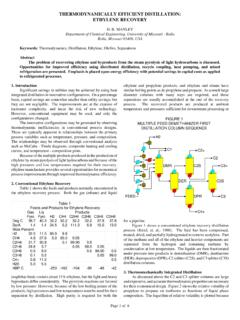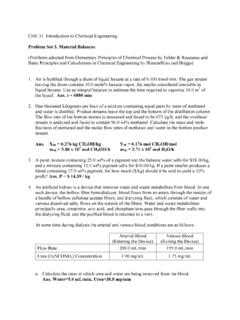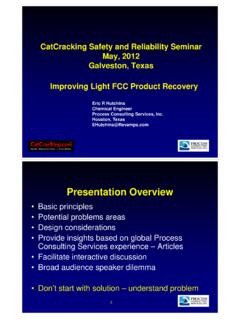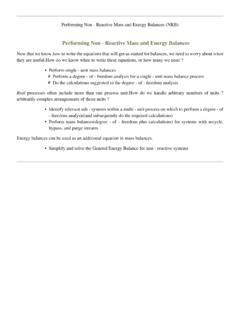Transcription of MODELLING AND ADVANCED PROCESS CONTROL (APC) FOR ...
1 MODELLING AND ADVANCED PROCESS CONTROL (APC) FOR distillation columns OF LINEAR ALKYLBENZENE PLANT Xiaoming Jin, Gang Rong and Shuqing Wang National Key Lab of Industrial CONTROL Technology, Institute of ADVANCED PROCESS CONTROL , Zhejiang University, 310027, Hangzhou, China email: Abstract: This paper introduces industrial application of model predictive CONTROL (MPC) for the series of columns in a linear alkylbenzene (LAB) complex. The APC system that is consisted of twelve controlled variables, twelve manipulated variables and eight disturbance variables is used to deal with the constrained multivariable CONTROL problem of the distillation columns . Firstly, PROCESS MODELLING that includes experimental test and PROCESS identification is presented. Then, the construction and implementation of the APC system for the distillation columns are discussed.
2 Industrial application results show that the APC system can maintain the best operation for a long time and realize ultimate operating potential of the distillation columns . Copyright 2003 IFAC Keywords: Model predictive CONTROL , distillation PROCESS , series of columns 1. INTRODUCTION distillation columns have been widely used for separation processes in the petroleum and chemical industries. These columns are not only the most energy-intensive operations, but also determine the quality of products of those industries and many times limit PROCESS product rates (Kister, 1990). Recent progresses in the CONTROL theory, computer and communication have made possible extensive application of APC in PROCESS industries (Wang et al, 2001). The large economic benefit of applying APC system to the distillation columns arises from reducing the deviations of crucial PROCESS variables and pushing the steady-state operation to a better operating point (Riggs, 1998).
3 distillation CONTROL has been studied extensively and poses many challenging problems since a distillation column is complex, highly non-linear, multivariable PROCESS (Shinskey, 1984, Luyben, 1992, Lundstrom and Skogestad, 1995). Recent efforts have contributed to the analysis of CONTROL properties of distillation sequences (Jimenez, et al, 2001) and comparison of CONTROL strategies for the distillation columns (Huang and Riggs, 2002). However, the APC system that deals with whole distillation columns rather than single column via a MPC controller is lack of report in open literature. This paper introduces industrial application via a commercial software of MPC for the distillation columns in a LAB plant, which consists of four distillation columns operated in series: HF acid stripper, benzene column, paraffin column, and LAB column.
4 A MPC system that is constructed of twelve controlled variables, twelve manipulated variables and eight disturbance variables is developed to deal with the constrained multivariable CONTROL problem of the distillation columns . The MPC system is divided to four subsystems according to the distillation column. Each subsystem is relatively independent with the others and mainly takes charge one column. Industrial application results show that the APC system can maintain the best operation for a long time and realize ultimate operating potential of the distillation system by reducing the consumption of energy, improving product purity, and minimizing operating cost. 2. PROCESS DESCRIPTION LAB now accounts for nearly all of the worldwide production of alkylbenzene sulfonates (LASs) that are frequently used as raw material of biodegradable household detergents.
5 A LAB complex consists of two major steps: production of normal paraffins, and production of LAB from normal paraffins. The straight run kerosene from a refinery is used to produce normal paraffins through kerosene pre-fractionation, distillate unionfining PROCESS and Molex PROCESS . Then, the normal paraffins are dehydrogenated to corresponding mono-olefins over a highly selective and active catalyst. Lastly, benzene is alkylated with mono-olefins to LAB using hydrofluoric (HF) acid as the catalyst in alkylation PROCESS . The alkylation PROCESS includes two major sections: alkylation section and distillation section. The distillation columns are researched in this paper. The PROCESS diagram of the distillation columns with the basic regulatory loops is shown in Figure 1.
6 The controlled variables (CVs) , manipulated variables (MVs) and disturbance variables (DVs) of the APC system are also given in Figure 1. The distillation columns include a HF acid stripper, a benzene column, a paraffin column, and a LAB column. The columns are operated to separate multi-component mixtures of LAB stream from upstream section. The separations of various distillation columns are key variables influencing the economic performance of the alkylation PROCESS since the series of columns directly affect product quality, product rate, and utility usage. The feed of the distillation columns is a mixed LAB stream with HF, benzene and paraffin from alkylation section, which passes through a feed heat exchanger enters at the top tray of the HF stripper.
7 The HF vapor is vented to the HF recovery system. The hot oil to the reboiler is on flow CONTROL . The bottom level is directly controlled by adjusting bottom product flow to the benzene column. The bottom temperature is a key variable that reflects fractionation effect. The HF stripper is typically not a bottleneck, but it can be disturbed by operation of alkylation section and flooded if overloaded. FCFCFCFCFCFCFCFCFCFCFCFCFCFCFCFCLCLCLCLC LCLCPCPCPCTITITITCTC120181630 Paraffin columnLAB columnHF acid stripperBenzene column Feed TI TITILCTILAB(MV2)(MV1)(CV1)(CV2)(CV3)(CV4 )(CV5)(MV3)(MV4)(MV5)(CV6)(CV7)(MV7)(CV8 )(CV9)(MV6)(MV9)(MV8)(CV10)(CV11)(MV10)( CV12)(MV11)(MV12)PIPCTI(DV1)FI(DV2)(DV4) (DV3)(DV5)TI(DV6)(DV7)(DV8) Fig. 1 PROCESS diagram of the distillation in LAB plant The benzene column has a whole condenser.
8 The pressure is controlled via a hot vapor bypass around the overhead condenser. The accumulator level is controlled by adjusting top benzene product flow rate. There is a flow limit for top benzene product in that it is returned to alkylation section. The hot oil to the reboiler and reflux to column are on flow CONTROL . The bottom level is directly controlled by adjusting bottom product flow to the paraffin column. There are two important temperatures in benzene column: upper tray temperature and lower tray temperature, which reflect distillation effect and are controlled variables. The benzene column is very sensitive to feed composition disturbance. When HF stripper is overloaded or operated unsteadily the upper tray temperature of benzene column can vary acutely and the lower tray temperature may exceed the lower limit, then influence the operation of the paraffin column.
9 The paraffin column is a typical packed column that is operating at a pressure slightly lower than atmospheric pressure. A jet pump is used to create and maintain the vacuum. The accumulator level is controlled by adjusting top paraffin product flow that is returned to dehydrogenation PROCESS of paraffin. The hot oil to the reboiler and hot reflux to column are on flow CONTROL , but the cool reflux to column is fixed. The bottom level is directly controlled by adjusting bottom product flow to the LAB column. There are two important temperatures in paraffin column: upper temperature and lower temperature, which reflect distillation effect and are used to direct normal operation. The paraffin column is very important to LAB productivity of the plant since any LAB in top paraffin product will suffer losses.
10 The paraffin column is the throughput bottleneck in the distillation columns , and can be easily overloaded. The LAB column is also a packed column and its operation is similar to the paraffin column s. The top product is LAB that can be used to produce LASs. There are also two important temperatures in LAB column: upper temperature and lower temperature, which reflect distillation effect and are used to instruct normal operation. The LAB column is a column of finished product in which any LAB in bottom heavy LAB product will suffer losses. It is important for the LAB column to maintain steady operation. In conclusion, the columns need to be maintained close to optimal operating conditions lay at some constraints. Nevertheless, regulatory controls of distillation column are difficult to achieve better CONTROL performance all the time for moving the column to its optimal operating point and rejecting disturbances on the controlled variables.
